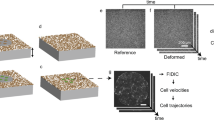Abstract
Recently I became interested in heterogeneity in collective cell migration. If some cells in a group move differenytly, how does that change the over- all group motion? For example, some cells can be more invasive in moving through tissues, which can be important in embryo development as well as cancer metastasis.
Access this chapter
Tax calculation will be finalised at checkout
Purchases are for personal use only
Similar content being viewed by others
Author information
Authors and Affiliations
Corresponding author
Editor information
Editors and Affiliations
Rights and permissions
Copyright information
© 2020 Springer Nature Switzerland AG
About this chapter
Cite this chapter
Schumacher, L., Maini, P., Baker, R. (2020). Semblance of Heterogeneity. In: Matthäus, F., Matthäus, S., Harris, S., Hillen, T. (eds) The Art of Theoretical Biology. Springer, Cham. https://doi.org/10.1007/978-3-030-33471-0_24
Download citation
DOI: https://doi.org/10.1007/978-3-030-33471-0_24
Published:
Publisher Name: Springer, Cham
Print ISBN: 978-3-030-33470-3
Online ISBN: 978-3-030-33471-0
eBook Packages: Biomedical and Life SciencesBiomedical and Life Sciences (R0)




